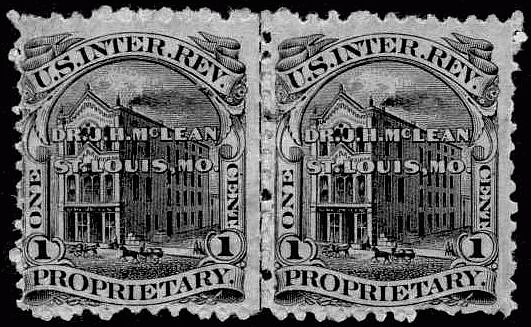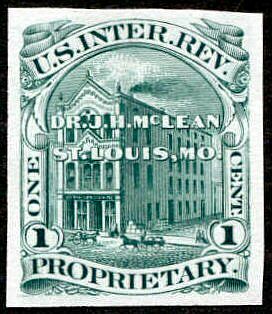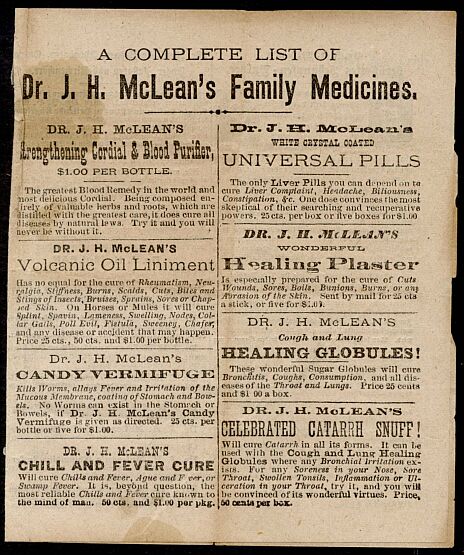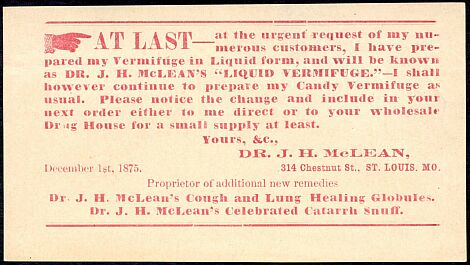
James Henry McLean

James Henry McLean had been interested in medicine as a boy in Nova Scotia, and gained most of his medical knowledge working for a pharmacist in Philadelphia as a teenager. Although he claimed to be a doctor, his formal training was likely to have been one medical course at the University of Philadelphia. He arrived in Saint Louis in 1849. He first appeared in the proprietary medicine field there in 1854-55, when he was connected with Mexican Mustang Liniment, later the property of Demas Barnes.
By the mid-1860's McLean was beginning to offer his own medicines - Dr. J.H. McLean's Celebrated Strengthening Cordial and Blood Purifier, Dr. J.H. McLean's Liver and Kidney Balm, Dr. J.H. McLean's Celebrated Catarrh Snuff and Dr. J.H. McLean's Volcanic Oil Liniment, among others. The Strengthening Cordial was reputedly 85 to 100 proof alcohol, and the Volcanic Oil Liniment was crude petroleum, if modeled after Mexican Mustang Liniment as the latter's owner claimed, in court.
McLean was a member of Congress for three months, filing an unexpired term, but was defeated for election to a full term after that. Around 1879 he decided that, as he had conquered illness, he would next conquer war Here is a look at his activities in that sphere.
The McLean stamp, showing his office building as it was at the time, was first issued April 12, 1867, and last issued on February 20, 1873. 6,045,270 of his stamps were printed on old paper, 10,780,160 on silk paper and 10,367,893 on pink and watermarked papers. The one shown is on silk paper.

Holcombe states that only one pair of the McLean stamps was known at the time. That is strange, as the stamps are not scarce in pairs, and probably were used that way for the higher-priced preparations. This pair is on watermarked paper.
The stamps show an entry dot just above the "c" in "cent" at the right, so were printed from a new plate probably prepared by the Bureau of Engraving and Printing. Earlier copies show the dot at upper right, above the design.

Copies that are imperforate vertically are known. Scott lists them as being on old paper, but Holcombe and Riley mention them as being on silk paper. This copy appears to have enough margin at top and bottom to be imperforate there, but it is impossible to be certain. It is on silk paper.
Note the entry dot in the upper right corner of the stamp. The information on these entry dot varieties comes from the article "Nostrum Wizard Cured" by Richard F. Riley in The American Philatelist, November, 1985.

A small die proof of the McLean stamp.

A trial color proof of the McLean stamp on India paper, mounted on card.

A trial color card proof.

In violation of regulations McLean put an image of his proprietary stamp on the back of his Family Almanac of 1871. Along with a diatribe against "avaricious and contemptible" imitators, the back cover tells how many of the stamps were on each McLean preparation.

The front of the 1871 almanac.

By 1875 McLean had moved the image of his proprietary stamp to the inside of the almanac cover. However, his claims as to the origin and purpose of the stamp are not likely to have endeared him to any IRS agent who may have noticed. "I have in former years cautioned the public against mean, contemptible parties, trying to imitate my Medicines, and to make it certain, the U.S. Government has prepared for me a special Stamp, which will be found on all my Medicines. I herewith print a facsimile, and say again: Do not take any medicines, unless they have my Private Government Seal on, like the one herewith printed."

The front of the 1875 almanac, featuring one of the McLean "before and after" illustrations.

An exploded box from Celebrated Catarrh Snuff. Note that the reverse of the box is written in German.

The instructions from the box also are written in English on one side, German on the other.

A list of medicines from the other side of the page shown above.

A bill from 1871.

McLean himself, looking from the front of a brochure promoting his Liver and Kidney Balm.

McLean's first laboratory, pictured on a cover. Other covers show the Tower Block and the rebuilt complex after the fire of 1883. They also show McLean's use of before and after graphics. Here is a small gallery of McLean covers.

Liquid Vermifuge was introduced in late 1875, according to this card which must have been used as a stuffer in a bill to a retailer.

A letter from McLean wanting a draft to pay for his insurance premium in 1875. He alludes to "financial trouble," but his operations were very successful at the time.

McLean issued "notes" which appear to have no monetary value in that they read, "The STATE OF MISSOURI will not pay ONE DOLLAR to bearer.. The backs of the notes contain advertising. There are at least three versions known.

Stereopticon card showing the McLean Tower Block, a landmark of downtown Saint Louis.

An 1890 almanac showing the new laboratory complex built after the 1883 fire. McLean died in 1886.

McLean's son married a Brandreth and moved to England, but the proprietary medicine operations were continued well into the Twentieth Century. Most sales were abroad, and almanacs were published in many languages. This one is in Bohemian.

The front of a box containing a full bottle of McLean's Volcanic Oil Liniment. Note that there is a zip code for the company!